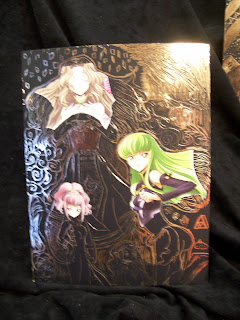Sunday, January 2, 2011
Van Gogh: 6th Graders' Aerial Perspective Landcapes
Aerial perspective is a technique that artists often use in painting to give the illusion of space on a 2-dimensional surface (such as a canvas or paper). The six graders' used techniques such as size, perspective, overlapping and color to help make their aerial perspective landscapes appear to have depth. To pull some art history into the lesson, we talked about Vincent Van Gogh, the well celebrated Post-Impressionist artist. The students were permitted to use either oil pastel or chalk pastel on this project and finished their artworks in the 'style' of Van Gogh by using gestural swirls and dynamic lines to show movement.
Gustav Klimt: 7th & 8th Graders Scratch to the Gold
If you've walked through the halls of ICMS recently, you may have noticed the beautiful works of art completed by 7th and 8th graders that inhabit the display cases. Praises from parents and teachers alike have been pouring in over these masterpieces!
For every project that the students do in my class, I like to do a 'quality sample', an example of what I want them to shoot for in their own art. The sample gives me an opportunity to see the challenges that the students may face with the medium, to demonstrate various techniques and to give those visual learners a goal to aspire towards. Often times, when showing the students the samples, I hear comments like these;
"No way can we do that!", "It's easy for you, you're an artist, Ms. Bullers!", "You've got to be kidding us, right?!"
There is the part where I tell them that they WILL do the same thing beautifully and successfully because I KNOW that they are capable!
Some lesson plans I make up myself; I like to think of lesson planning as MY form of art. Others I get from varying sources. This particular lesson plan, I found on the internet and I thought it to be brilliant.
It's easy to get a good reaction from students when you show them the work of Gustav Klimt. The numerous shapes, unique patterns, intricate designs and well-crafted gold leaf applications in Klimt's turn of the century Art Nouveau works captures the admiration of many. The Kiss (1907–1908)and Portrait of Adele Bloch-Bauer I (1907) are some of his most famous paintings from this Austrian symbolist painter's 'Golden Phase'.
To incorporate the same effect of patterns with gold leaf, the students used an art medium called scratch board. Scratch board is essentially a piece of cardboard with a thin layer of India ink that is scratched into with a sharp tool to reveal a layer of golden foil underneath.
Each student chose an image from a magazine that they liked, cut it and glued it to the surface of their scratch board. Then, they were to scratch in some piece that was missing from their image. For example, Gustav Klimt would often paint realistic faces onto his canvas and then finish their clothing with pattern gold leaf. Finally, the students broke up the background of their scratch boards with beautifully intricate patterns.
For every project that the students do in my class, I like to do a 'quality sample', an example of what I want them to shoot for in their own art. The sample gives me an opportunity to see the challenges that the students may face with the medium, to demonstrate various techniques and to give those visual learners a goal to aspire towards. Often times, when showing the students the samples, I hear comments like these;
"No way can we do that!", "It's easy for you, you're an artist, Ms. Bullers!", "You've got to be kidding us, right?!"
There is the part where I tell them that they WILL do the same thing beautifully and successfully because I KNOW that they are capable!
Some lesson plans I make up myself; I like to think of lesson planning as MY form of art. Others I get from varying sources. This particular lesson plan, I found on the internet and I thought it to be brilliant.
It's easy to get a good reaction from students when you show them the work of Gustav Klimt. The numerous shapes, unique patterns, intricate designs and well-crafted gold leaf applications in Klimt's turn of the century Art Nouveau works captures the admiration of many. The Kiss (1907–1908)and Portrait of Adele Bloch-Bauer I (1907) are some of his most famous paintings from this Austrian symbolist painter's 'Golden Phase'.
To incorporate the same effect of patterns with gold leaf, the students used an art medium called scratch board. Scratch board is essentially a piece of cardboard with a thin layer of India ink that is scratched into with a sharp tool to reveal a layer of golden foil underneath.
Each student chose an image from a magazine that they liked, cut it and glued it to the surface of their scratch board. Then, they were to scratch in some piece that was missing from their image. For example, Gustav Klimt would often paint realistic faces onto his canvas and then finish their clothing with pattern gold leaf. Finally, the students broke up the background of their scratch boards with beautifully intricate patterns.
Subscribe to:
Comments (Atom)




















































